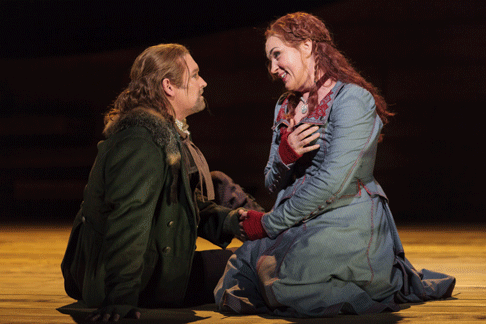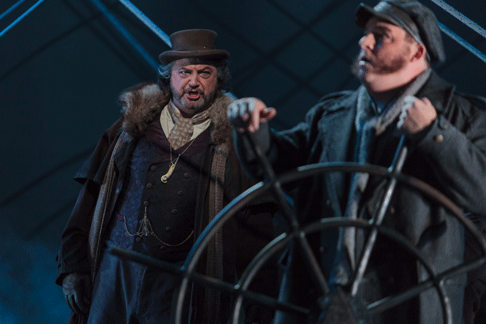17 Jul 2013
Glimmerglass Festival’s ‘The Flying Dutchman’ a voyage to remember
Excellent staging and strong vocal efforts put wind in the sails of this legendary ghost ship

Excellent staging and strong vocal efforts put wind in the sails of this legendary ghost ship
The sultry weather outside the Alice Busch Opera Theater in Cooperstown, New York moved indoors for an erotic and riveting production of The Flying Dutchman that put all the characters’ sexual frustrations front and center. Call it “Tennessee Williams meets Richard Wagner at the Glimmerglass Festival.”
This work, the first to announce Wagner’s distinctive style, is based on a nautical legend as retold by the poet Heinrich Heine. The Dutchman has been doomed to sail the world as punishment for uttering a blasphemous oath. Every seven years he is permitted to step on land to seek a woman who will be faithful to him and provide him release from the curse. So far, no luck.
As envisioned by Director Francesca Zambello, who is also the Festival’s Artistic and General Director, this Dutchman needs female companionship in the worst way, and who can blame him? As a result, one key prop in this production is a bed, specifically Senta’s bed. She is the latest object of his desire — and his hope for release.
Fortunately for him, Senta is obsessed with the legend of the Flying Dutchman. After the justly famous overture, Zambello places Senta on the bed in the midst of a nightmare as a storm rages off the coast of Norway. She is enveloped in a black cloud of cloth, flailing wildly as she foresees her own doom.
The bed returns when Senta gives herself to the Dutchman as a sign of her enduring fidelity. She will save him from his accursed wandering. Her Dutchman is bare chested — save for a large Gothic tattoo that covers most of his skin. (It is painstakingly drawn on his chest before each performance.) Bass-baritone Ryan McKinny as the Dutchman has the abs and the arms to make this seduction convincing, although if this production had been staged in Germany, and not Central New York, Zambello might have taken more risks. Still, steam was coming off the bed.
Then Senta greets her sad sack, discarded boyfriend Erik, on this bed. He almost convinces her to remain faithful. The Dutchman spies on this scene of partial reconciliation and assumes Senta is like all the other women he’s met in his endless wanderings and abandons her, returning once again to the sea.
Finally, on this bed Senta in despair commits suicide using a rope — a second key image in this production.
 Jay Hunter Morris as Erik and Melody Moore as Senta
Jay Hunter Morris as Erik and Melody Moore as Senta
Ropes are everywhere. They hang from scaffolding that frames the stage both right and left. Sailors hang onto them for dear life to suggest the raging storm that has delayed their return to Norway and to their girlfriends. They pull on the ropes at the end of Act 1 to inflate the mast once a south wind has returned.
In the spinning scene, the village girls each have ropes suspended from the scaffolding to their laps. Rather than sew, they braid these ropes — often using them erotically to suggest their own sexual frustration as they await the return of their sailor-lovers.
The ropes also envelope Senta’s bed, as if they were bars to a jail she will never leave alive.
The Heine legend says that the Dutchman’s cursed ship had blood-red sails. Zambello’s lighting director Mark McCullough has suggested this through the frequent use of a red spotlight on the Dutchman and with red backlighting for the rigging of his ship. In the rigging one could see bodies — perhaps of the women who had already lost their lives by being unfaithful to the Dutchman, or perhaps of his ghostly crewmembers. Spooky it was. Had this been a Broadway show, McCullough’s lighting throughout the production was worthy of garnishing a Tony Award.
All of this was in service to a splendid cast that was strong from top to bottom. Wagner’s score was sung as well as one is likely to hear it in a house of this size (914 seats).
In the title role, McKinny was most effective when singing quietly, as when he first tells Senta his sad story in Act 2. He is a bit light of voice for the role, but this made sense given that he was portrayed as a young and ardent captain, seemingly not much older than Senta. McKinny is a good actor, able to make a real person of this mythical sailor.
Melody Moore was a sensational Senta. She hit all the exposed high notes of her famous Ballad without scooping or straining, as if nailing the notes was no big deal. She offered none of the blowzy singing that sometimes afflicts others who sing this part. She delivered the role with both power and lyricism.
The role of Daland, Senta’s father, was sung heartily by Peter Volpe, who has a cavernous but also agile bass voice. It was a clear contrast to the lighter voice of the Dutchman. He captured the comic absurdity of this money-grubbing father who is wiling to sell off his daughter to a rich, mysterious captain of a ghost ship, ignoring that this Dutchman might not be such a great son-in-law. Directors can’t do much with this character that Wagner didn’t make explicit, and Volpe seems to have found just what the composer intended.
 Peter Volpe as Daland (left) and Adam Bielamowicz as the Steersman
Peter Volpe as Daland (left) and Adam Bielamowicz as the Steersman
Erik, Senta’s shunned boyfriend, is often played and sung as a wimp — as if Don Ottavio had wandered out of Don Giovanni and into the wrong opera. Not here. Jay Hunter Morris, who has sung Siegfried in both New York and San Francisco (with Zambello) to great acclaim, assumed the role. He was physically rough with Senta, no wimp at all. His voice was large for this house and thrilling, if a bit nasal. His Act 3 aria, in which he begs Senta to stick with him, was melting in its delivery. This was an Erik worthy of a forging scene. A bit more Bellini-type vocalism would have helped (this is, after all, an early Wagner work), but I’ll take it.
Glimmerglass Young Artist Adam Bielamowicz was a sympathetic steersman with a tenor voice as clear as spring water. A second Young Artist, Deborah Nansteel, was a most capable Mary, Senta’s nurse — a somewhat thankless part.
The men and women of the chorus sang and acted with polish. Conductor John Keenan led a fleet performance — about as far from the classic, lumbering, but celebrated Otto Klemperer EMI recording as one could get. Occasionally balances were off and the brass and winds rode over the strings. After a wonderful clarion opening from the horn in the overture, it was a hit or miss afternoon for the brass section. But overall the orchestra acquitted itself honorably. (This was the first time Glimmerglass has ever presented one of the 10 canonic Wagner operas.)
Oddly, Zambello chose to break the opera for an intermission at the point in Act 2, when Senta first sees the Dutchman. In dramatic terms this makes sense, since it leaves the audience wondering how she will react. It also splits the opera into nearly two equal parts. But for those who know the score, it was jarring. Wagner knew how to end his acts in slam-bang fashion, and this was not it. I would have preferred either a single two-hour performance with no break, or the three-act version with the endings Wagner wrote. But this is a small quibble.
Zambello’s reputation as a Wagner director was established, at least for me, in her San Francisco “Eco-Ring.” This production of The Flying Dutchman convinces me that she has a lot to say about this composer. She saw, as The New Grove Dictionary of Opera suggests, that Wagner identified with his “sexually unfulfilled protagonist.” This is a production Wagner would recognize, and no doubt appreciate.
This review first appeared at CNY Café Momus. It is reprinted with the permission of the author.